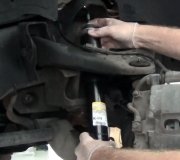Struts don't make noise that way. They can cause a clunk over bumps or if they're real bad they can clunk when changing directions. Based on your observations, it's much more likely the noise is coming from the control arm bushings. By forcing them to go to a position they don't normally travel to when you replaced the struts, you wore off a little sample of rust or corrosion and you exercised the rubber bushings to in effect lubricate them. The clue is they're quiet for a day. Ball joints can act that way too but they typically won't quiet down for a day.
There's two ways to find the source of the noise. The fastest is to head to the Chrysler dealer's parts department for a can of "Spray White Lube". You can probably get something similar other places but this is what I'm familiar with and I know it works. Spray it liberally on the control arm bushings, then drive the car for a day. It may takes some time for the noise to stop, but if it does, you're identified the cause. That is a lithium-based grease with a watery-like substance that flows into tight places and takes the grease with it. The liquid evaporates and leaves the grease behind. When I did this to my noisy suspension, a coating lasted anywhere from two days to a month.
The second method starts with listening with a stethoscope while a helper bounces the car. If that doesn't work, there is a tool called the "Chassis Ear" that you might be able to find at an auto parts store that borrow or rents tools. Be aware many mechanics have never heard of it. It's a set of six microphones you clip to suspect parts, a switch box, and head phones. You switch between the microphones while listening during a test drive. That can be a real effective way to find noises.
Wednesday, August 31st, 2011 AT 7:10 PM



